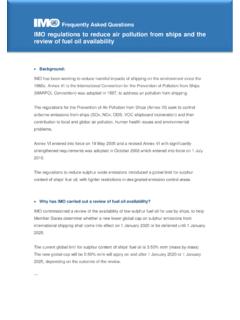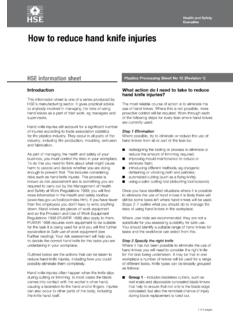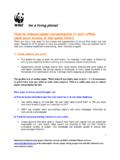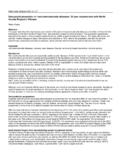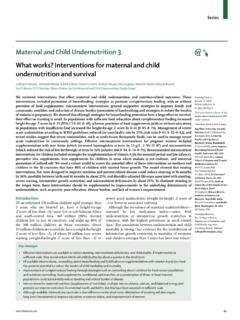Transcription of Global food losses and food waste - Extent, causes …
1 11. IntroductionThe issue of food losses is of high importance in the efforts to combat hunger, raise income and improve food security in the world s poorest countries. food losses have an impact on food security for poor people, on food quality and safety, on economic development and on the environment. The exact causes of food losses vary throughout the world and are very much dependent on the specific conditions and local situation in a given country. In broad terms, food losses will be influenced by crop production choices and patterns, internal infrastructure and capacity, marketing chains and channels for distribution, and consumer purchasing and food use practices. Irrespective of the level of economic development and maturity of systems in a country, food losses should be kept to a losses represent a waste of resources used in production such as land, water, energy and inputs.
2 Producing food that will not be consumed leads to unnecessary CO2 emissions in addition to loss of economic value of the food produced. Economically avoidable food losses have a direct and negative impact on the income of both farmers and consumers. Given that many smallholders live on the margins of food insecurity, a reduction in food losses could have an immediate and significant impact on their livelihoods. For poor consumers ( food insecure or at-risk households), the priority is clearly to have access to food products that are nutritious, safe and affordable. It is important to note that food insecurity is often more a question of access (purchasing power and prices of food ) than a supply problem. Improving the efficiency of the food supply chain could help to bring down the cost of food to the consumer and thus increase access. Given the magnitude of food losses , making profitable investments in reducing losses could be one way of reducing the cost of food .
3 But that would, of course, require that financial gains from reduced losses are not outweighed by their much food is lost and wasted in the world today and how can we prevent food losses ? Those are questions impossible to give precise answers to, and there is not much ongoing research in the area. This is quite surprising as forecasts suggest that food production must increase significantly to meet future Global demand. Insufficient attention appears to be paid to current Global food supply chain losses , which are probably substantial. For the international congress Save food ! at Interpack2011, FAO hired the services of the Swedish Institute for food and Biotechnology (SIK) to carry out two studies on the extent and effects, as well as causes and prevention of food losses and food waste , one for high/medium-income countries, and one for low-income countries. The two studies highlighted the food losses occurring along food chains, and made assessments of the magnitude of these losses , focussing on quantitative weight losses .
4 They compile, analyze and assemble data and reports produced on the topic of Global food loss and waste during recent years. Where information was not available, assessments and assumptions have been made. Results of the two studies are combined in this MethodologyThe Swedish Institute for food and Biotechnology (SIK) has reconstructed mass flows of food aimed to human consumption, from production to consumption, using available data, in order to quantify food losses and DEFInItIOn OF food losses AnD food wAStEFood losses refer to the decrease in edible food mass throughout the part of the supply chain that specifically leads to edible food for human consumption. food losses take place at production, post-harvest and processing stages in the food supply chain (Parfitt et al., 2010). food losses occurring at the end of the food chain (retail and final consumption) are rather called food waste , which relates to retailers and consumers behavior.
5 (Parfitt et al., 2010). food waste or loss is measured only for products that are directed to human consumption, excluding feed and parts of products which are not edible. Per definition, food losses or waste are the masses of food lost or wasted in the part of food chains leading to edible products going to human consumption . Therefore food that was originally meant to human consumption but which fortuity gets out the human food chain is considered as food loss or waste even if it is then directed to a non- food use (feed, ). This approach distinguishes planned non- food uses to unplanned non- food uses, which are hereby accounted under tyPES OF food losses /wAStEFive system boundaries were distinguished in the food supply chains (FSC) of vegetable and animal commodities. food loss/ waste were estimated for each of these segments of the FSC. The following aspects were considered:Vegetable commodities and products:Agricultural production: losses due to mechanical damage and/or spillage during harvest operation ( threshing or fruit picking), crops sorted out post-harvest, handling and storage: including losses due to spillage and degradation during handling, storage and transportation between farm and : including losses due to spillage and degradation during industrial or domestic processing, juice production, canning and bread baking.
6 losses may occur when crops are sorted out if not suitable to process or during washing, peeling, slicing and boiling or during process interruptions and accidental : including losses and waste in the market system, at wholesale markets, supermarkets, retailers and wet : including losses and waste during consumption at the household commodities and products:Agricultural production: for bovine, pork and poultry meat, losses refer to animal death during breeding. For fish, losses refer to discards during fishing. For milk, losses refer to decreased milk production due to dairy cow sickness (mastitis).Chapter 2 Methodology3 Post-harvest handling and storage: for bovine, pork and poultry meat, losses refer to death during transport to slaughter and condemnation at slaughterhouse. For fish, losses refer to spillage and degradation during icing, packaging, storage and transportation after landing. For milk, losses refer to spillage and degradation during transportation between farm and : for bovine, pork and poultry meat, losses refer to trimming spillage during slaughtering and additional industrial processing, sausage production.
7 For fish, losses refer to industrial processing such as canning or smoking. For milk, losses refer to spillage during industrial milk treatment ( pasteurization) and milk processing to, , cheese and : includes losses and waste in the market system, at wholesale markets, supermarkets, retailers and wet : includes losses and waste at the household QuAntIFICAtIOn OF food losses AnD wAStEPhysical mass of food produced for human consumption and of food lost and wasted throughout the food supply chain have been quantified, using available data, results from the literature on Global food waste and SIK s own assumptions. For each commodity group a mass flows model was used to account for food losses and waste in each step of the commodity s FSC. Model equations are provided in Annex 5. The production volumes for all commodities (except for oil crops and pulses) were collected from the FAO Statistical Yearbook 2009 (FAOSTAT 2010a).
8 The production volumes for oil crops and pulses were collected from FAO s food Balance Sheets (FAOSTAT 2010d).Allocation factors have been applied to determine the part of the produce oriented to human consumption (and not for animal feed). Conversion factors have been applied to determine the edible mass (Annex 2).At each stage of the food Supply Chain, losses and waste were estimated using FAO s food Balance Sheets from the year 2007 and results from a thorough literature search on the topic of Global food waste . Where there are gaps of knowledge, SIK has made own assumptions and estimations, based on food waste levels in comparable regions, commodity groups and/or steps of the FSC. The figures used are presented in Annex 4. The sources and assumptions behind these estimations are described in detail in the study reports from SIK.










